Coquito Tres Leches is a light-as-air sponge cake soaked in the traditional Puerto Rican holiday coconut and rum cocktail. Tres leches is a well-known (and beloved) dessert in Hispanic countries that’s also found a place in American hearts. Even kids can enjoy this recipe if you make it with a virgin coquito. Looking to amp up an adult party? Go the whole hog with the alcoholic coquito version. A layer a fluffy whipped cream topping is the final touch on this epic dessert.
*I’ve updated the article, originally published in November 2020, to clarify the instructions for better success.*
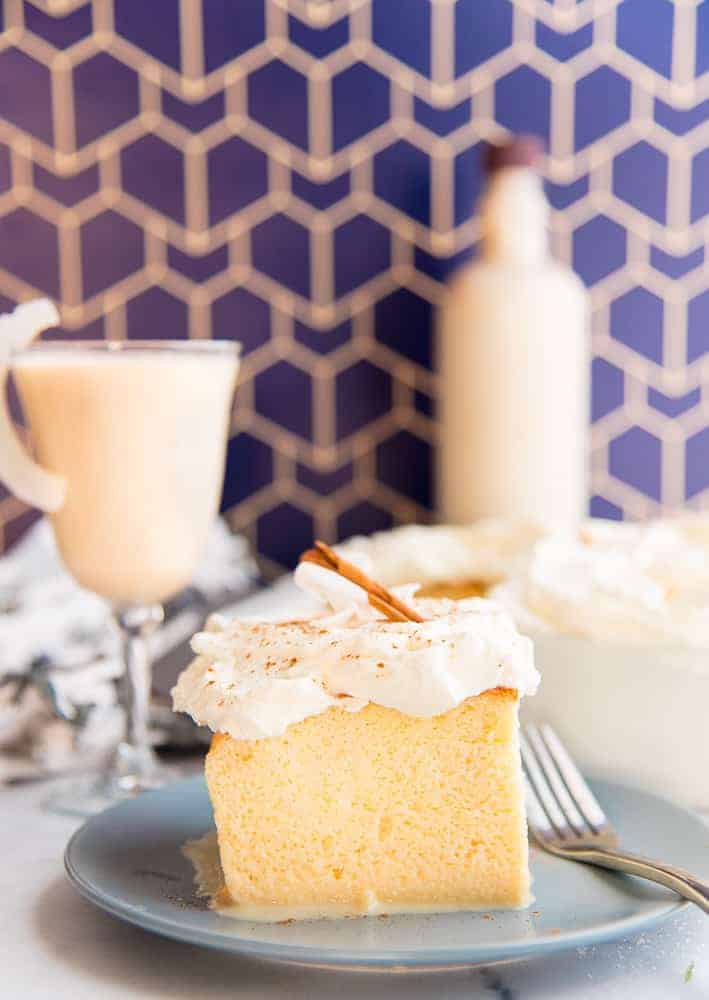
What is Coquito?
Coquito is a popular Puerto Rican holiday cocktail made with coconut, rum, and a blend of milk and spices.
Families gather during the holidays to mix their own versions of coquito to bottle and distribute amongst each other. Coquito was made with fresh coconut cured in bottles with pitorro (or sugar cane moonshine) back in the old days. Now, sadly, we turned mostly to using canned milk, but nonetheless, the legend lives on.
What is Tres Leches?
Tres leches, Spanish for “three milks,” cake is a Hispanic dessert of sponge cake that is soaked in a combination of three kinds of milk, hence the name. After combining the milks, the mixture is poured over the baked sponge cake to soak into every nook and cranny- usually overnight. A whipped cream frosting is then spread over the cake before the tres leches cake is enjoyed.
The most popular kinds of milk used in tres leches are evaporated, sweetened condensed, and whole milk.
The worst thing you can do is make a tres leches cake with a boxed cake mix. Besides my general disdain for boxed cake mixes, tres leches cakes made with boxed cake mixes come out sloppy and soggy instead of plump and oozing milk. This is the main reason most people complain about tres leches. A soggy, crumbly tres leches cake results from not using a sponge cake to make it.
Do I Need to Make Coquito to Make This Recipe?
I do recommend using homemade coquito to make coquito tres leches cake. I also suggest you use an alcohol-free version since kids are likely to eat it and the alcohol won’t cook off.
You can replace the coquito for this tres leches cake with a quick coquito if you don’t have time to make it from scratch. Though I always recommend using fresh coconut milk, canned coconut milk from the store, sweetened condensed milk (coconut if you can find it), and evaporated milk is all you need to make the quick version.
What Ingredients Do I Need to Make Coquito Tres Leches?
Coquito tres leches cake is made with eggs, cake flour, sugar, a small amount of cream of tartar (not pictured), and rum (or a rum extract). I swear this is the easiest recipe ever.
The three-milk mixture requires an alcohol-free coquito if you already have it prepared since the coquito has three milks in it already. You need coconut milk (canned or fresh), evaporated milk, sweetened condensed milk (sweetened condensed coconut milk is great here), and rum and cinnamon extracts to make the quick version, though.
The final component in this coquito tres leches cake is a rum-flavored whipped cream. You need heavy cream, granulated sugar, and rum extract (or real rum).
What’s the Best Way to Separate Eggs for My Sponge Cake?
Sponge cake is hands down, the best cake for all tres leches recipes. The name itself implies why. The texture of sponge cake- its small pockets of air- absorbs the tres leches mixture and suspends it inside the cake. Sponge cakes don’t rely upon chemical leaveners, like baking soda or baking powder, to give them volume. Instead, eggs and an easy pan technique are all you need to get the most volume in your sponge cake.
Separate the egg whites from the yolks while the eggs are cold. Cold eggs are easier to separate because they are firmer, and the yolk tends to break less. Cracking the eggs into your hands is the best way to separate the whites from the yolks because your hand doesn’t have sharp edges. If you are skeevy about touching raw eggs, use an egg separator or do the back-and-forth between the shells method.
Place the egg whites into an extremely clean bowl. Fat inhibits egg whites from whipping to their fullest potential. Put the yolks in a larger bowl since that’s where the batter begins and ends. Now allow the eggs to warm to room temperature. Warm eggs whip higher than cold eggs do.
Sift the cake flour two times to aerate it. Sifting your flours for cakes makes the cakes bake up light and fluffy. Set the cake flour aside for now.
How Do I Properly Whip the Eggs for the Sponge Cake?
Always whip the egg whites for your sponge cake first. Because fat inhibits egg whites from attaining volume, so you’re more likely to introduce fat to the whites if you first whip the yolks. Again, whip your egg whites while they warm. I usually put the sugar for my cake recipe in the oven as it preheats, only for 5 minutes, to add even more warmth to my whipping eggs, but this is optional.
Begin whipping the egg whites with a hand mixer at 2nd speed. Add the cream of tartar, which strengthens the egg whites, once the whites begin to foam up. Increase the mixing speed to 4 (or medium-high) and whip the whites for another 2-3 minutes or until the whites look milky.
Gradually sprinkle in the first portion of sugar while whipping constantly.
After all the sugar is added, continue whipping the whites until they look snowy-white, which usually takes 6-7 minutes. The whites should hold a peak that stands straight out from the beaters.
The egg yolks are much less finicky than the whites. You should complete this stage as quickly as possible, though, because the whites lose volume with every minute.
Add your favorite dark rum (or rum extract) and the remaining sugar to the bowl with the yolks.
Beat the mixture on high speed with an electric hand mixer for 3-4 minutes. Stop the mixer and scrape down the beaters and the sides of the bowl. Return the beaters to the bowl and whip for 2-3 minutes, or until the yolks are lemony yellow and the beaters leave a thick ribbon behind in the yolks as they pass through.
How Do I Finish the Sponge Cake?
Fold the sifted flour and whipped whites into the egg yolk mixture in stages.
Begin by sifting half of the cake flour into the bowl of yolks. Use a large rubber spatula to gently fold the flour into the yolks.
Next, fold in half of the whipped egg whites. Don’t go all wild folding in the whites. Be gentle, so you don’t deflate the whites or the yolks. Repeat the sifting of the remaining flour over the yolks, followed by gently folding in the last of the whites. Remember, the more volume you keep, the higher your cake will rise.
How Long Do I Bake the Sponge Cake?
Quickly pour the prepared batter into an ungreased 9 by 13-inch cake pan. This goes against everything you’ve ever been taught about baking cakes, but there’s a method to the madness. The sponge cake, which, again, has no chemical leavener, needs to grip onto something. If you spray the cake pan with baking spray, all it’s going to do is slide right back down the pan and go nowhere.
Avoid using non-stick cake pans for this recipe, too. They also hinder the cake from gripping the sides. Ungreased, ceramic, glass or metal pans are best.
Place the pan into a preheated 400°F (204°C) oven and bake it for 15 minutes. Once baked, the cake will have risen and become a deep golden brown.
How Do I Make the Coquito if I Don’t Have Any Prepared?
Make your coquito mixture- if you don’t have any prepared- while the cake bakes.
To make your coquito for tres leches:
- Combine a can of coconut milk, evaporated milk, sweetened condensed milk, rum extract or rum, ground cinnamon, ground nutmeg, and a pinch of allspice in a mixing bowl.
- Use an immersion blender to blend them, or you can do this in a blender.
- Add 1/2 cup of white, dark, or spiced rum to the mixture if you don’t plan to serve this coquito tres leches to kids. If you do, replace the rum with a 1/2 cup of water or coconut water.
I usually make a spice tea when I make my coquito, but since we’re looking for a quick option here, that’s unnecessary. Using ground spices will work perfectly.
Blend everything together until the mixture is smooth and fluid.
Can I Make This Dairy-Free?
To make a dairy-free coquito tres leches cake, replace the evaporated milk with another can of coconut milk and the sweetened condensed milk with sweetened condensed coconut milk.
Use a dairy-free whipped topping in place of the whipped cream topping.
How Long Do I Need to Soak the Coquito Tres Leches?
Remove the sponge cake from the oven and put it on a cooling rack, but allow it to cool completely in the pan. Allowing the cake to cool while still “stuck” to the sides of the baking dish keeps it at the same volume. If you try to remove it now, it will not only stick to the pan (remember we didn’t grease it), but it will also sink and deflate. Just leave it in the baking dish until the dish and cake no longer feel hot on the top, sides, or bottom. Putting it on the cooling rack allows air to circulate under the pan. Cooling the cake usually takes 40-45 minutes.
Poke holes all over the cake using a wooden skewer or a toothpick after the cake is completely cool. Please only use one of these. This isn’t a poke cake, so don’t go stabbing it with the end of a spoon or a huge dowel. Poking big holes in your sponge cake causes your tres leches cake to break apart when you serve it.
There Seems to Be Too Much Coquito Tres Leches for My Sponge Cake
Use a paring knife to loosen the sides of the cake from the cake pan. Make sure the cake is completely cool before you do this.
Use a 1-cup ladle to pour the coquito tres leches over the baked cake. Space out the pours- 10-minute increments should do it- to give the tres leches a chance to soak into the sponge cake. The cake will absorb the milk mixture, and you can continue to pour more on once it’s no longer visible. Bubbles will let you know that the coquito tres leches is being absorbed by the cake. Pour all of the milk over the cake.
Towards the end, puddles of milk will form on the sides of the pan. That’s okay. The cake will continue to soak up the coquito tres leches as it chills in the fridge.
How Long Does the Cake Have to Soak in the Coquito Tres Leches?
Cover the cake pan in aluminum foil and carefully transfer the dish to the fridge. Allow the coquito tres leches to soak into the cake for at least 6 hours. Overnight is preferred.
Making it ahead allows the cake to absorb that coquito tres leches mixture fully. Keep the cake covered in the fridge until you’re ready to frost it.
How Do I Finish the Coquito Tres Leches?
The best topping for coquito tres leches is rum-flavored whipped cream and a sprinkle of ground cinnamon. Whip the cream topping two hours before you plan to serve the coquito tres leches.
Add the heavy cream, rum extract, and cinnamon extract to a chilled metal bowl. Whip the cream with an electric hand mixer on medium speed for 2 minutes. Start sprinkling in the sugar once the beaters leave ribbons on the surface of the cream. Increase the mixer’s speed to high once all the sugar has been added, and whip for 2-3 more minutes or until the cream is fluffy and stiff.
Frost the coquito tres leches at least 2 hours before you plan to serve it if you can. The whipped cream creates this syrupy deliciousness between the cake and the whipped cream that is mind-blowing. You can always frost the cake further ahead, too. If you can’t spare the 2-hour advanced frosting, frost the coquito tres leches whenever possible.
Use an offset spatula to spread the whipped cream onto the surface of the cake. Make sure you leave pretty swoops! Finally, lightly dust the coquito tres leches with ground cinnamon.
How Do I Store the Coquito Tres Leches?
Because this is a dairy-laden cake, you must store coquito tres leches in the refrigerator at all times unless you’re serving it.
You don’t need to cover it since the whipped cream is doing that, but do be sure to keep it chilled.
How Do I Serve Coquito Tres Leches?
Slice the coquito tres leches into squares and serve it on its own or with a glass of coquito. I enjoy mine with café con leche to temper all that coquito going on.
How Do I Store Leftover Coquito Tres Leches?
Store coquito tres leches in a covered container in the fridge for up to 3 days. Avoid keeping coquito tres leches at room temperature for a long time since it contains so much dairy.
You can press a piece of plastic wrap or wax paper against any cut sides to keep it from drying out in the fridge. You can cover it after cutting it if you opt not to press anything against the interior.
Can I Freeze Tres Leches Cake?
You can freeze coquito tres leches for 2 months. Wrap the cake dish in a couple layers of plastic wrap before you freeze it, and make sure the pan you’re freezing it in is freezer-safe.
Thaw the coquito tres leches in the refrigerator overnight, then cut and serve.
See why this Coquito Tres Leches is so popular during the holiday season. Be sure to pin this recipe to your holiday dessert boards, then share it with your friends and family!
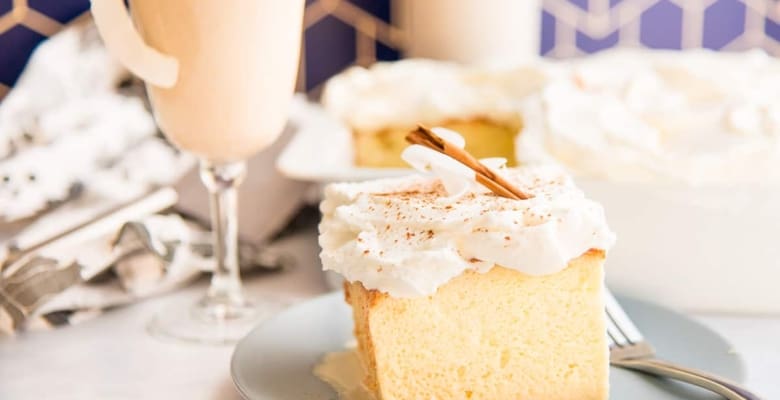
Coquito Tres Leches
at Sense & EdibilityEquipment
- 9x13x3 inch cake pan (metal, glass or ceramic is best)
- electric mixer
- 4 cups of prepared coquito
Ingredients
For the Rum Sponge Cake
- 1 1/2 cups (173 grams) cake flour sifted
- 6 large eggs cold
- 1 cup (200 grams) granulated sugar separated
- 1/4 teaspoon cream of tartar
- 1 tablespoon (15 milliliers) dark rum (or rum or vanilla extract)
- 1/2 teaspoon (3 grams) kosher salt
For the Coquito Milk Mixture
- 4 cups (1 liter) prepared alcohol-free coquito *see notes to make quick coquito
- 1 tablespoon (15 milliliters) rum extract or vanilla extract
- 1 teaspoon (5 milliliters) cinnamon extract
For the Rum Whipped Cream
- 2 1/2 cups (625milliliters) heavy cream
- 1 teaspoon (5 milliliters) rum extract or dark rum
- 1 teaspoon (5 milliliters) cinnamon extract
- 1/4 cup (50 grams) granulated sugar
Optional Garnishes
- ground cinnamon for dusting on the frosted cake
- shredded coconut
Instructions
Prepare the Sponge Cake Batter
- Preheat your oven to 400°F.
- Separate the egg whites from the yolks while the eggs are cold. Place the egg whites into an extremely clean bowl. Put the yolks in a larger bowl since that's where the batter begins and ends. Now allow the eggs to warm up to room temperature.
- Sift the cake flour two times to aerate it. Sifting your flours for cakes makes the cakes bake up light and fluffy. Set the cake flour aside for now.
- Once the egg whites are at room temperature, begin whipping them with a hand mixer at 2nd speed. Add the cream of tartar once the whites begin to foam up. Increase the mixing speed to 4 (or medium-high) and whip the whites for another 2-3 minutes or until the whites look milky.
- Gradually sprinkle in 1/4 cup (50 grams) of sugar while whipping constantly. After all the sugar is added, continue whipping the whites until they look snowy-white, which usually takes 6-7 minutes. The whites should hold a peak that stands straight out from the beaters.Set the bowl aside.
- Add the remaining 3/4 cup (150 grams) of sugar, the rum and the kosher salt to the bowl with the yolks. Beat the mixture on high speed with an electric hand mixer for 3-4 minutes.
- Stop the mixer and scrape down the beaters and the sides of the bowl. Return the beaters to the bowl and whip for 2-3 minutes, or until the yolks are lemony yellow and the beaters leave a thick ribbon behind in the yolks as they pass through.
- Begin by sifting half of the flour into the bowl with the whipped yolks. Use a large rubber spatula to gently fold the flour into the yolks. Next, fold in half of the egg whites. Fold gently so as not to deflate the whites or the yolks. Repeat the sifting of the remaining flour over the yolks, followed by gently folding in the last of the whites.
Bake, Then Cool the Sponge Cake in the Pan
- Quickly pour the prepared batter into an ungreased 9 by 13-inch cake pan. Place the pan into a preheated 400°F (204°C) oven and bake it for 15 minutes. Once baked, the cake will have risen and become a deep golden brown.
- Remove the sponge cake from the oven and put it on a cooling rack, but allow it to cool completely in the pan until the dish and cake no longer feel hot on the top, sides, or bottom. Cooling the cake usually takes 40-45 minutes.
Prepare the Coquito (If Needed) While the Cake Cools (See Notes if You Don't Have Prepared Coquito)
- Whisk together the coquito, rum extract, and cinnamon extract the mixture is smooth and fluid.Keep the mixture in the fridge for later.
Soak the Cooled Cake
- Poke holes all over the cake using a wooden skewer or a toothpick after the cake is completely cool.Use a paring knife to loosen the sides of the cake from the cake pan. Make sure the cake is completely cool before you do this.
- Use a 1-cup ladle to pour the coquito tres leches over the baked cake. Space out the pours in 10-minute increments to give the tres leches a chance to soak into the sponge cake. The cake will absorb the milk mixture, and you can continue to pour more on once it's no longer visible. Bubbles will let you know that the coquito tres leches is being absorbed by the cake. Pour all of the milk over the cake.
- Towards the end, puddles of milk will form on the sides of the pan. That's okay. The cake will continue to soak up the coquito tres leches as it chills in the fridge. Cover the cake pan in aluminum foil and carefully transfer the dish to the fridge. Allow the coquito tres leches to soak into the cake for at least 6 hours. Overnight is preferred. Keep the cake covered in the fridge until you're ready to frost it.
Prepare the Rum Whipped Cream
- Add the heavy cream, rum extract, and cinnamon extract to a chilled metal bowl. Whip the cream with an electric hand mixer on medium speed for 2 minutes.
- Start sprinkling in the sugar once the beaters leave ribbons on the surface of the cream. Increase the mixer's speed to high once all the sugar has been added, and whip for 2-3 more minutes or until the cream is fluffy and stiff.
Frost, Then Enjoy the Coquito Tres Leches
- Frost the coquito tres leches at least 2 hours before you plan to serve it if you can using an offset spatula to spread the whipped cream onto the surface of the cake. Lightly dust the coquito tres leches with ground cinnamon. Garnish with coconut flakes, if desired.
- Refrigerate the Coquito Tres Leches until you're ready to serve it.Slice the coquito tres leches into squares and serve it on its own or with a glass of coquito or café con leche. Enjoy within 3 days of soaking.
Notes
Quick Coquito Recipe:
- 1 12 ounce-can (354 milliliters) evaporated milk
- 1 14-ounce can (396 grams) sweetened condensed milk
- 1 13.5-ounce can (400 milliliters) coconut milk
- 1/2 cup (120 milliliters) rum (for adult cake) or coconut water or water (for kid's cake)
- 1 tablespoon (15 milliliters) rum extract or rum
- 1 teaspoon (2 grams) ground cinnamon
- 1/2 teaspoon (1 gram) ground nutmeg
- pinch of allspice
- Add all of the ingredients in a mixing bowl.
- Use an immersion blender to blend them, or you can do this in a blender.
- Store in the refrigerator until ready to use.
Swaps and Substitutions:
- Replace the rum in any of the components with rum extract, vanilla extract, or cinnamon extract.
- To make a dairy-free coquito tres leches cake, replace the evaporated milk with another can of coconut milk and the sweetened condensed milk with sweetened condensed coconut milk. Use a dairy-free whipped topping in place of the whipped cream topping.
Tips and Techniques:
- Avoid using non-stick cake pans for this recipe. They also hinder the cake from gripping the sides. Ungreased, ceramic, glass or metal pans are best.
- Poking big holes in your sponge cake causes your tres leches cake to break apart when you serve it.
- Soaking the cake for at least 6 hours allows the cake to absorb that coquito tres leches mixture fully.
- If you can't spare the 2-hour advanced frosting, frost the coquito tres leches whenever possible.
Storage Instructions:
- Because this is a dairy-laden cake, you must store coquito tres leches in the refrigerator at all times unless you're serving it.
- Store coquito tres leches in a covered container in the fridge for up to 3 days.
- Avoid keeping coquito tres leches at room temperature for a long time since it contains so much dairy.
- You can press a piece of plastic wrap or wax paper against any cut sides to keep it from drying out in the fridge.
- You can cover it after cutting it if you opt not to press anything against the interior.
Freezer Instructions:
-
To freeze prepared coquito tres leches:
- Wrap the cake dish in a couple layers of plastic wrap before you freeze it, and make sure the pan you're freezing it in is freezer-safe.
- Freeze the cake for 2 months.
- Thaw the coquito tres leches in the refrigerator overnight, then cut and serve.

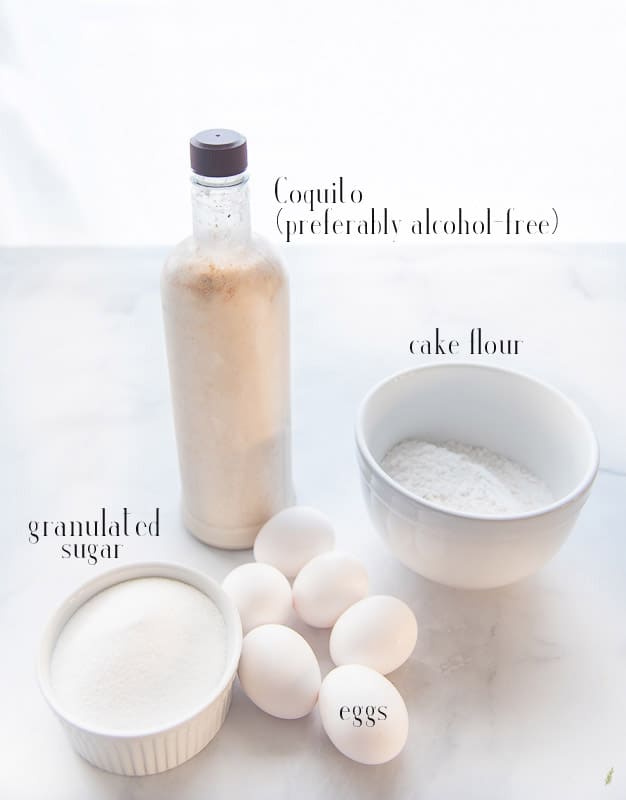
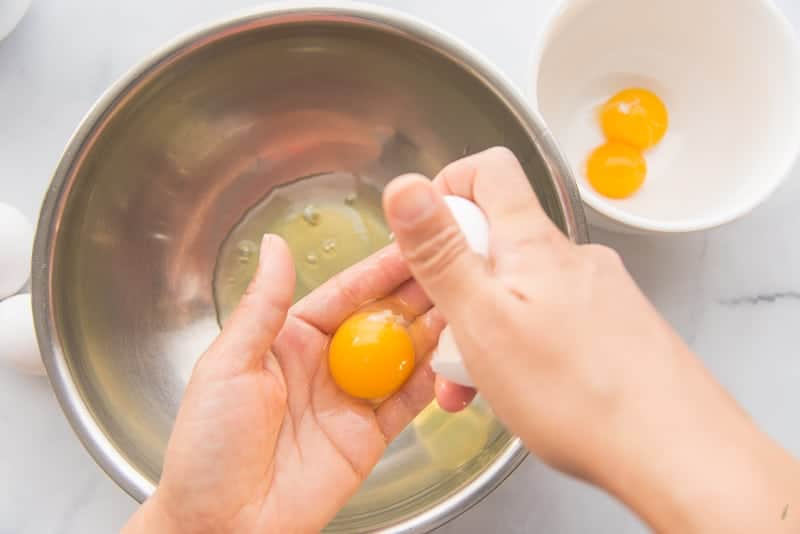
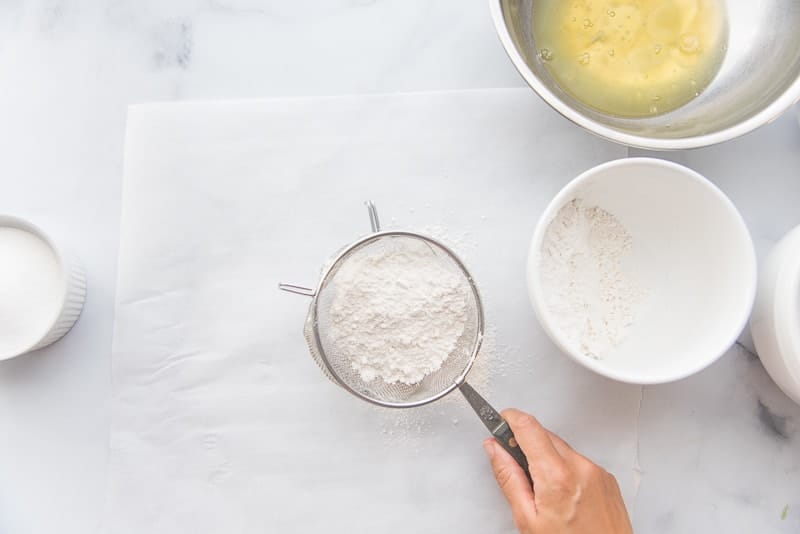
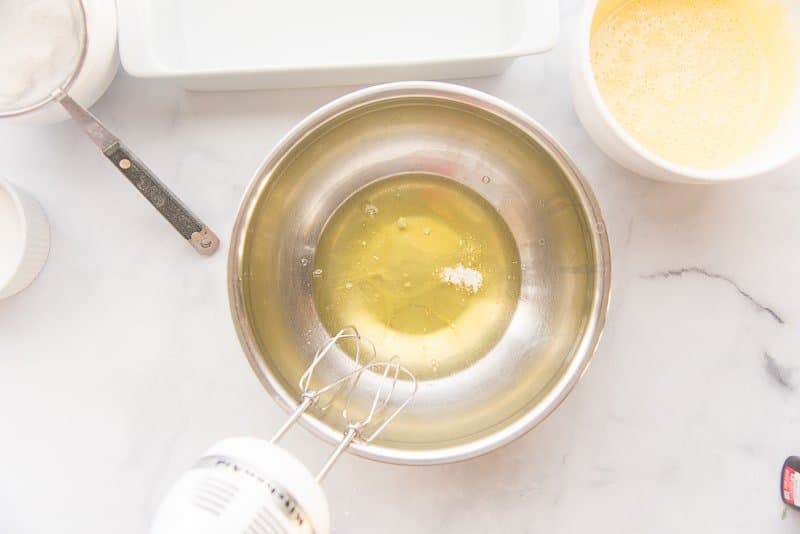
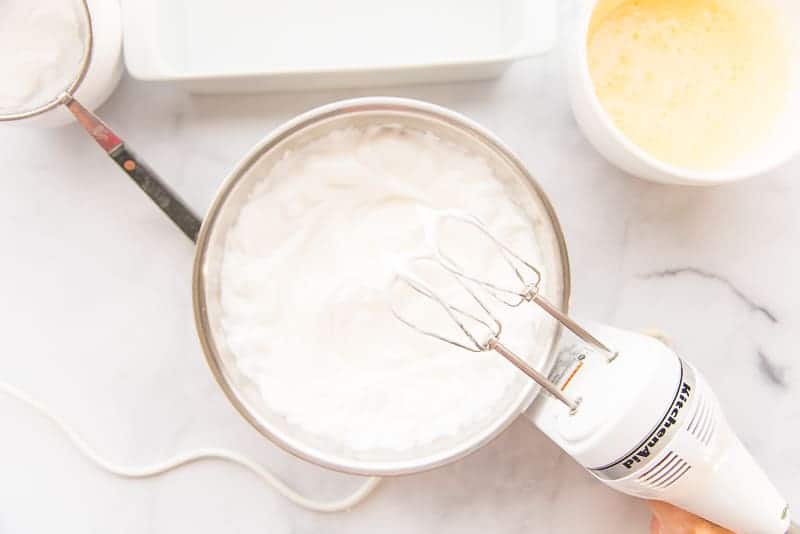
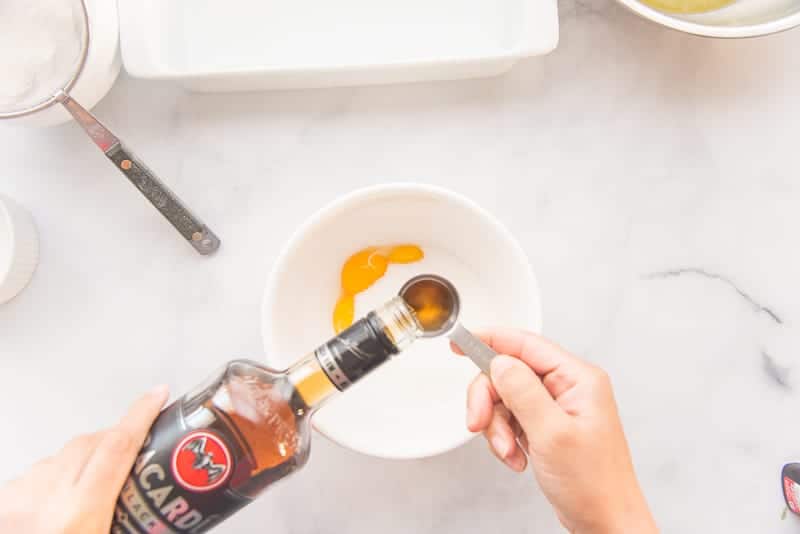
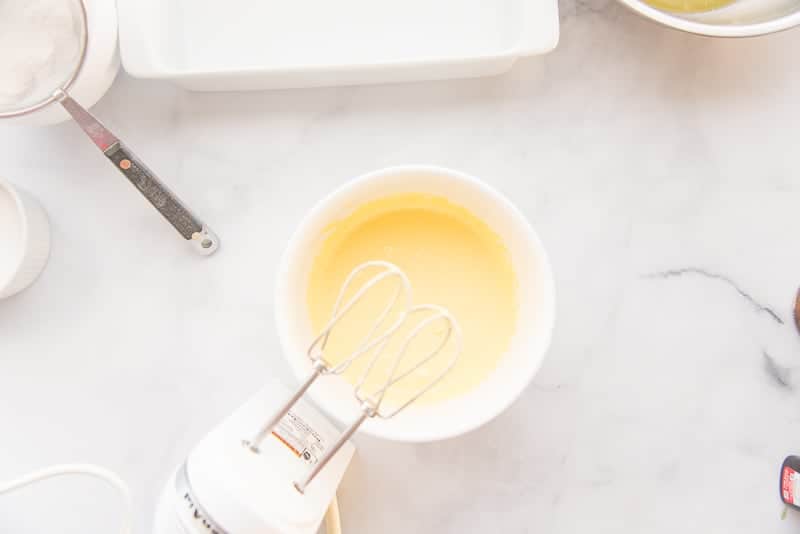
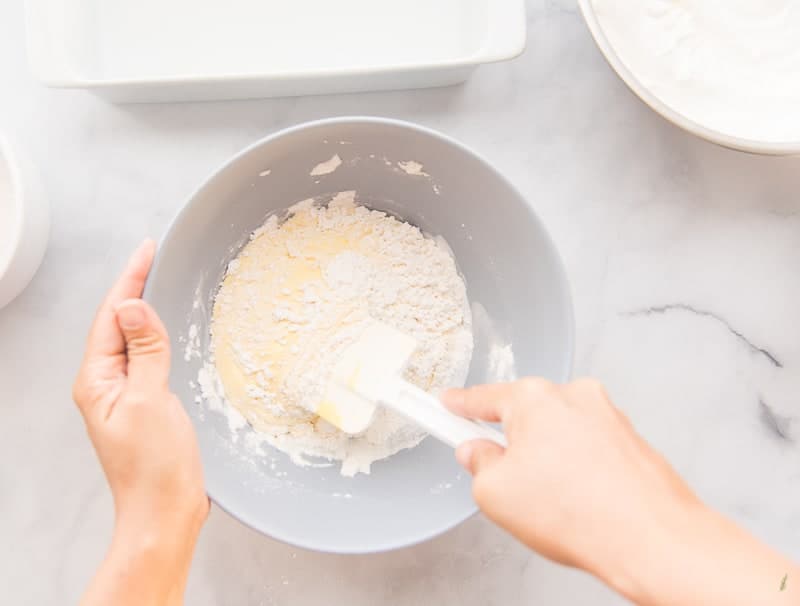
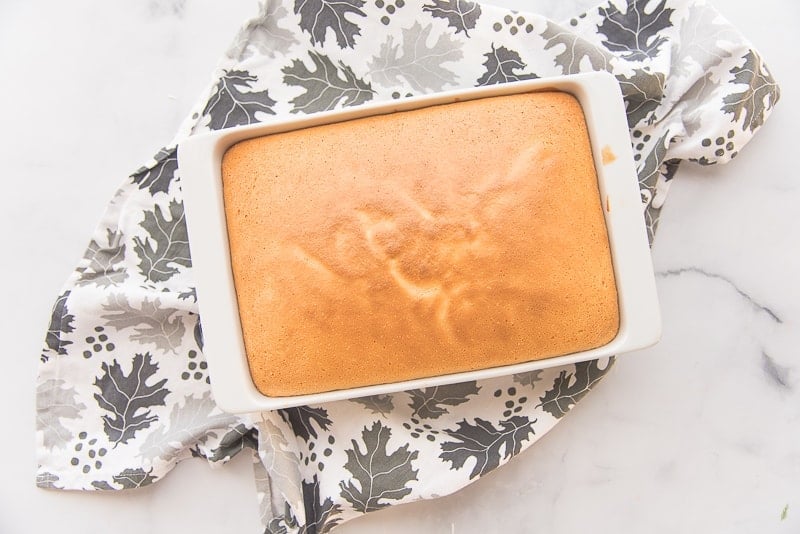
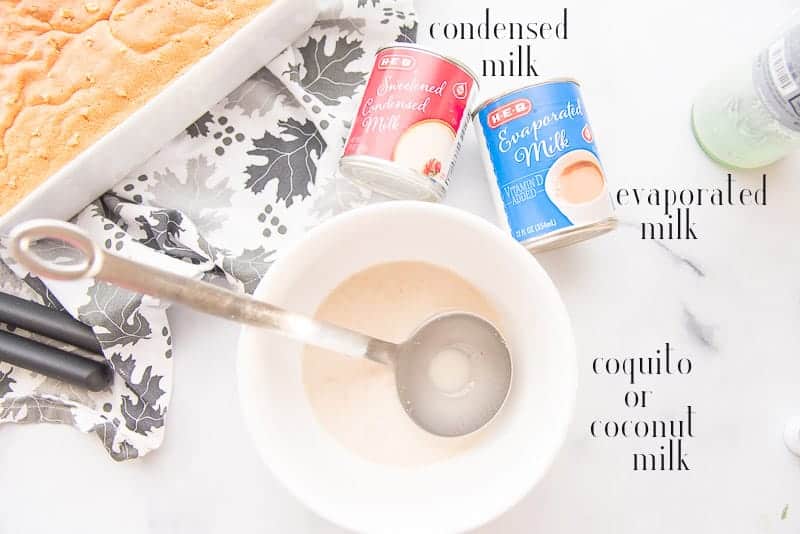
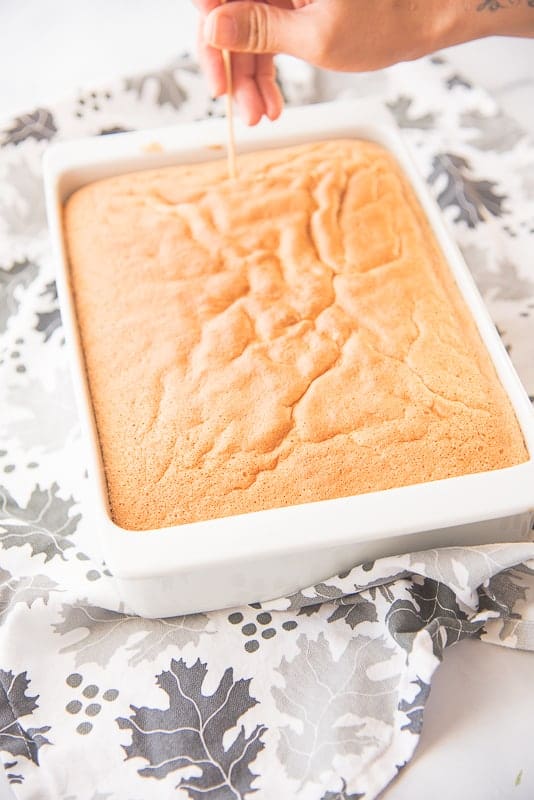
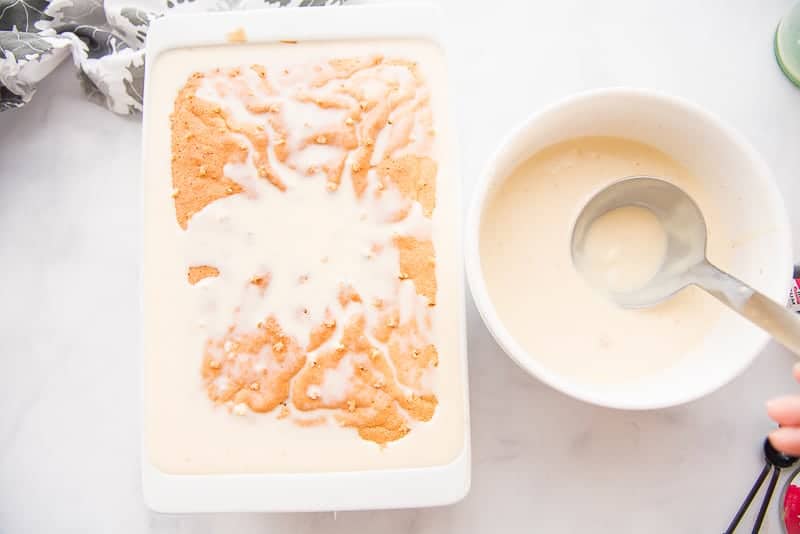
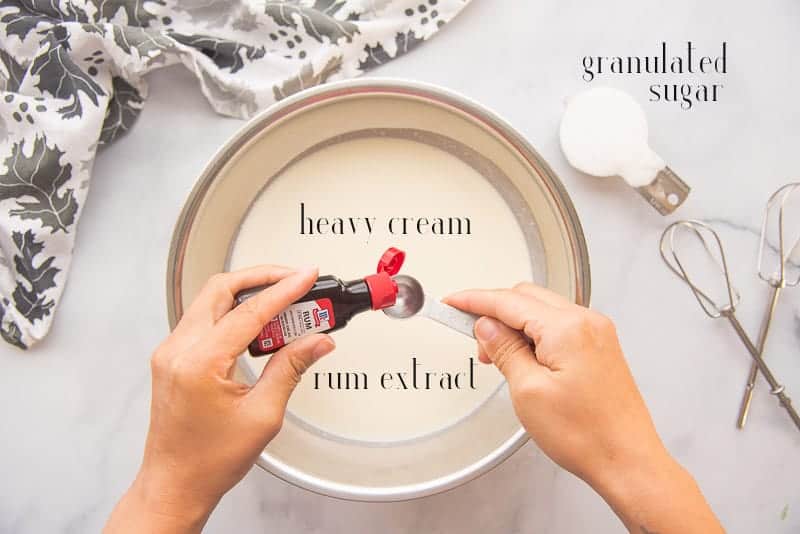
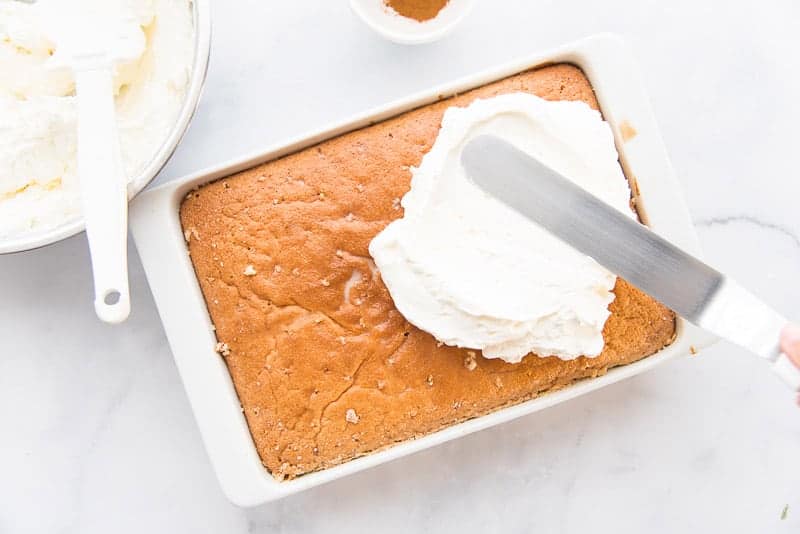
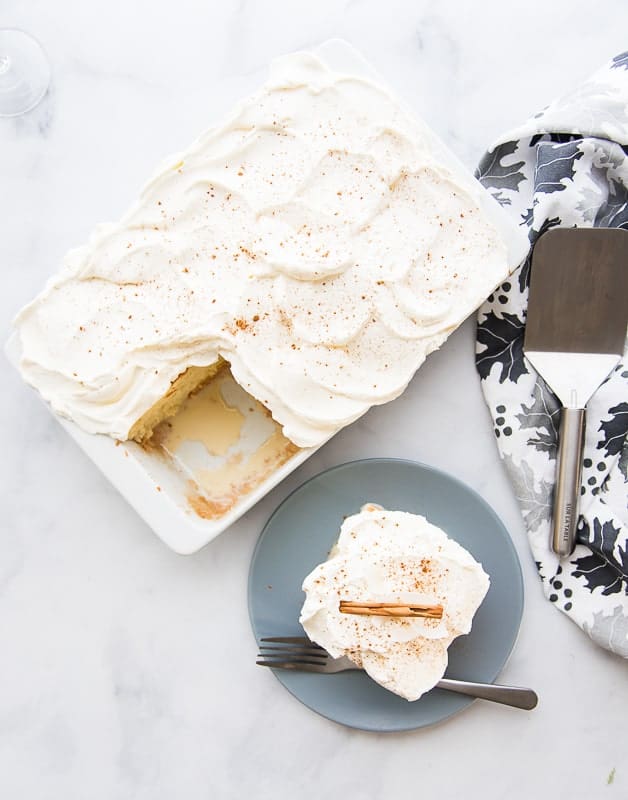
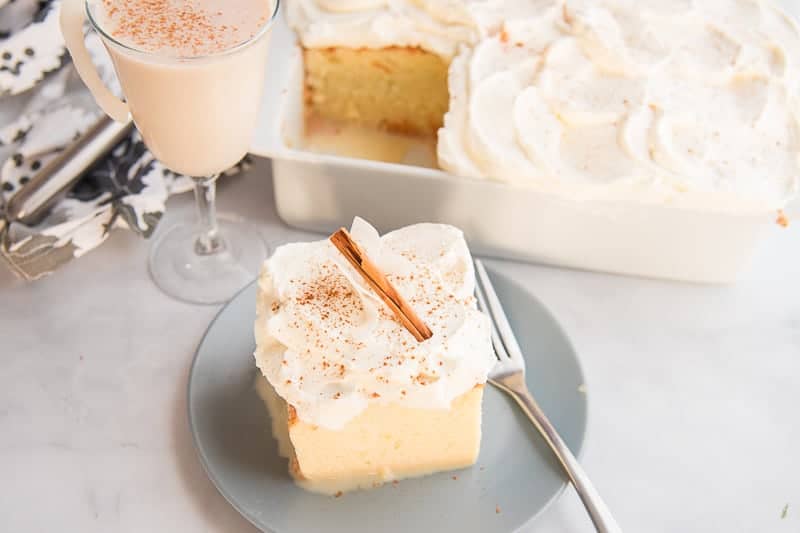
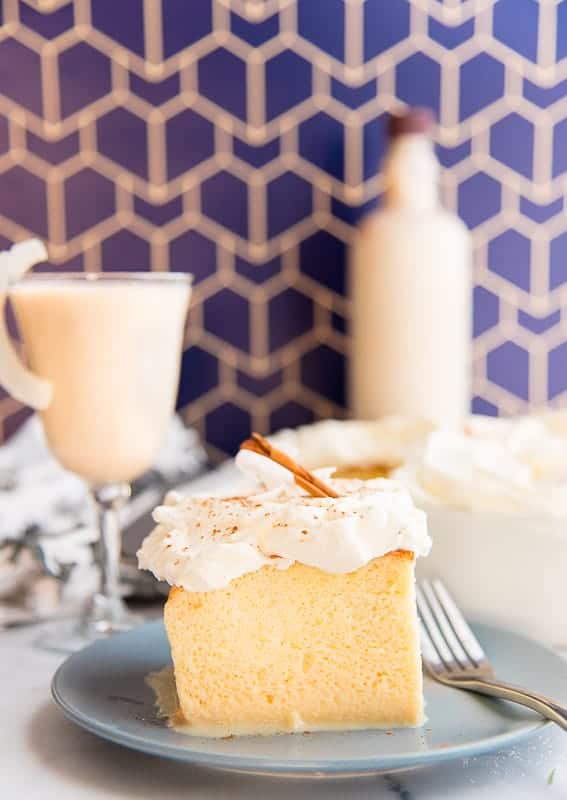
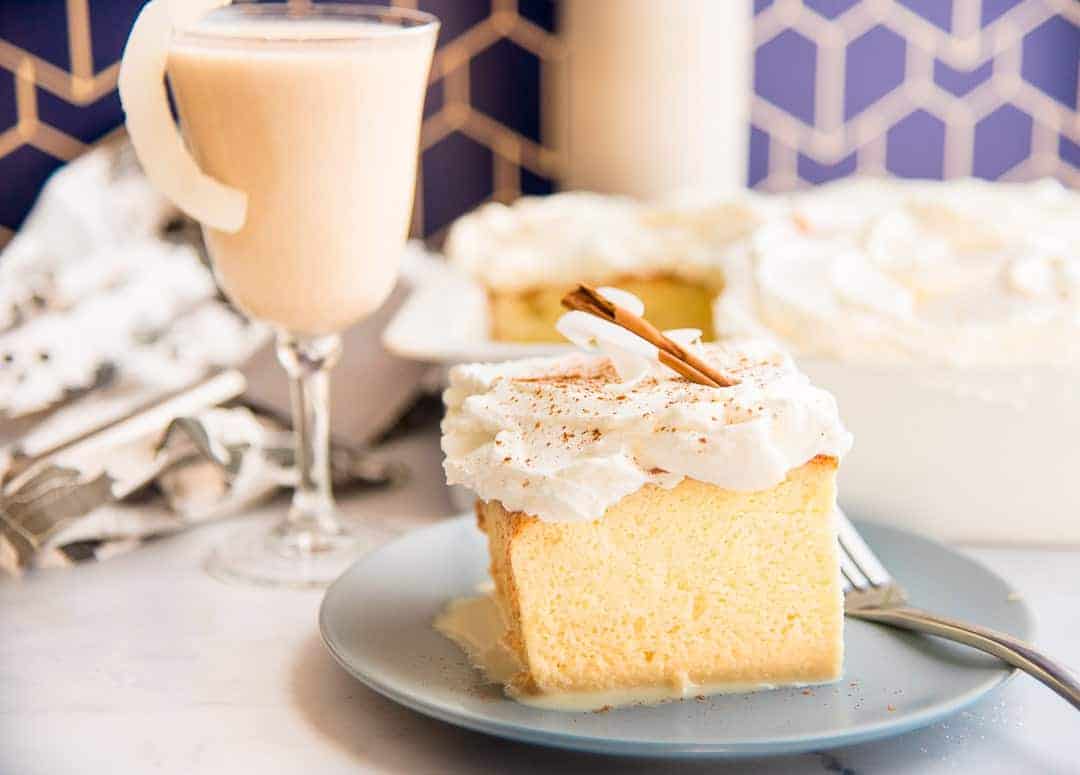
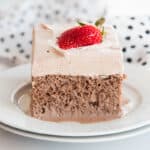




Just made this cake for a family luncheon and it was DELICIOUS!! My kids said it tastes like coconut limber. Haha. I made two, one with coconut rum and one without. It was such a big hit. The sponge was perfect to soak up all this delicious milk. Great recipe and fantastic instructions so thank you. Besitos from Upstate NY. 😉
It DOES taste like limber, now that I read your comment, LOL! Thank you for trying the recipe and commenting. I’m so glad you and your family enjoyed it!
Made this today! Tastes like home!
I know, right?!
I haven’t finished this yet but I made the cake, let it cool, then released the sides, poked holes in it, added maybe a 1/3 of the coquito and left it for about 3 hours and the cake is not soaking the coquito up. It’s all sitting on top. Maybe the coquito is too dense? :-/. What do I do? The coquito recipe we use is : 1 can coco lopez, 4 oz evaporated milk, 1 can sweetened condensed milk, 1 can coconut milk, 3/4 cup rum. Any suggestions?
If you mean cream of coconut (coco lopez), it’s too dense to soak into the cake. The fat from the cream combined with the thickness of the sweetened condensed milk is making the coquito mixture too thick and it probably won’t soak up. The only thing you can do dilute it with more coconut milk and some coconut water or milk and only use 4 cups (total including what you’ve already added).
Posted this to Dawn, but wanted to post for Marta. I followed the recipe to the point and I have the same problem. The cake floated on the liquid. Why is this?
There’s a few reasons this can happen. If you used a different coquito recipe, it might be too thick to be absorbed by the cake. If you sprayed the pan and the cake didn’t rise properly, the cake is too dense to absorb the liquid. If you didn’t poke holes in the cake, it will take longer to absorb the liquid. If you didn’t mix the cake properly or use the ingredients called for, it’s not spongy enough to absorb the liquid.
If you can think back on any of the steps and tell me what you think was the issue, I can better help you troubleshoot it.